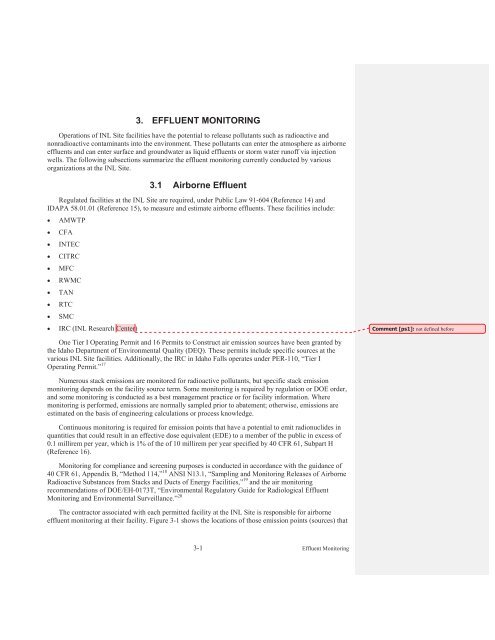Idaho National Laboratory Environmental Monitoring Plan
Idaho National Laboratory Environmental Monitoring Plan
Idaho National Laboratory Environmental Monitoring Plan
You also want an ePaper? Increase the reach of your titles
YUMPU automatically turns print PDFs into web optimized ePapers that Google loves.
3. EFFLUENT MONITORING<br />
Operations of INL Site facilities have the potential to release pollutants such as radioactive and<br />
nonradioactive contaminants into the environment. These pollutants can enter the atmosphere as airborne<br />
effluents and can enter surface and groundwater as liquid effluents or storm water runoff via injection<br />
wells. The following subsections summarize the effluent monitoring currently conducted by various<br />
organizations at the INL Site.<br />
3.1 Airborne Effluent<br />
Regulated facilities at the INL Site are required, under Public Law 91-604 (Reference 14) and<br />
IDAPA 58.01.01 (Reference 15), to measure and estimate airborne effluents. These facilities include:<br />
AMWTP<br />
CFA<br />
INTEC<br />
CITRC<br />
MFC<br />
RWMC<br />
TAN<br />
RTC<br />
SMC<br />
IRC (INL Research Center)<br />
Comment [ps1]: not defined before<br />
One Tier I Operating Permit and 16 Permits to Construct air emission sources have been granted by<br />
the <strong>Idaho</strong> Department of <strong>Environmental</strong> Quality (DEQ). These permits include specific sources at the<br />
various INL Site facilities. Additionally, the IRC in <strong>Idaho</strong> Falls operates under PER-110, “Tier I<br />
Operating Permit.” 17<br />
Numerous stack emissions are monitored for radioactive pollutants, but specific stack emission<br />
monitoring depends on the facility source term. Some monitoring is required by regulation or DOE order,<br />
and some monitoring is conducted as a best management practice or for facility information. Where<br />
monitoring is performed, emissions are normally sampled prior to abatement; otherwise, emissions are<br />
estimated on the basis of engineering calculations or process knowledge.<br />
Continuous monitoring is required for emission points that have a potential to emit radionuclides in<br />
quantities that could result in an effective dose equivalent (EDE) to a member of the public in excess of<br />
0.1 millirem per year, which is 1% of the of 10 millirem per year specified by 40 CFR 61, Subpart H<br />
(Reference 16).<br />
<strong>Monitoring</strong> for compliance and screening purposes is conducted in accordance with the guidance of<br />
40 CFR 61, Appendix B, “Method 114,” 18 ANSI N13.1, “Sampling and <strong>Monitoring</strong> Releases of Airborne<br />
Radioactive Substances from Stacks and Ducts of Energy Facilities,” 19 and the air monitoring<br />
recommendations of DOE/EH-0173T, “<strong>Environmental</strong> Regulatory Guide for Radiological Effluent<br />
<strong>Monitoring</strong> and <strong>Environmental</strong> Surveillance.” 20<br />
The contractor associated with each permitted facility at the INL Site is responsible for airborne<br />
effluent monitoring at their facility. Figure 3-1 shows the locations of those emission points (sources) that<br />
3-1 Effluent <strong>Monitoring</strong>
















